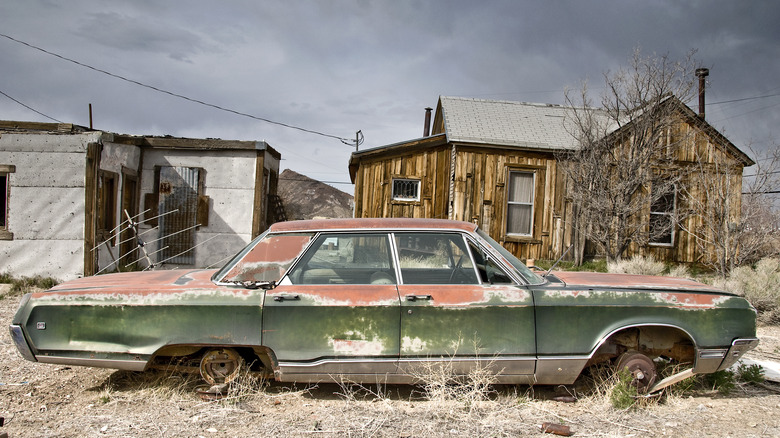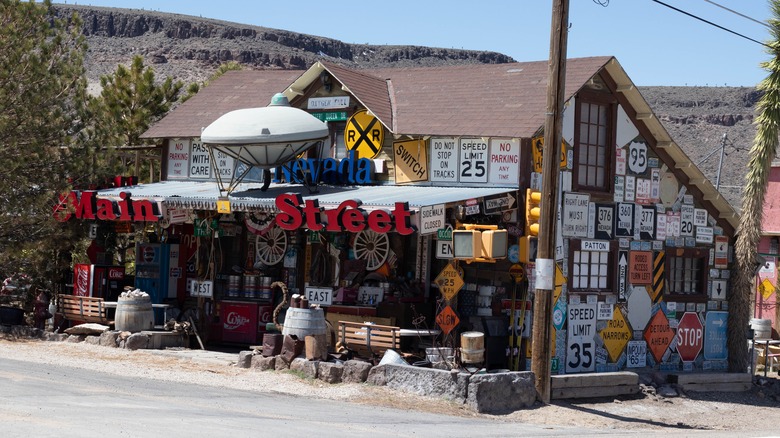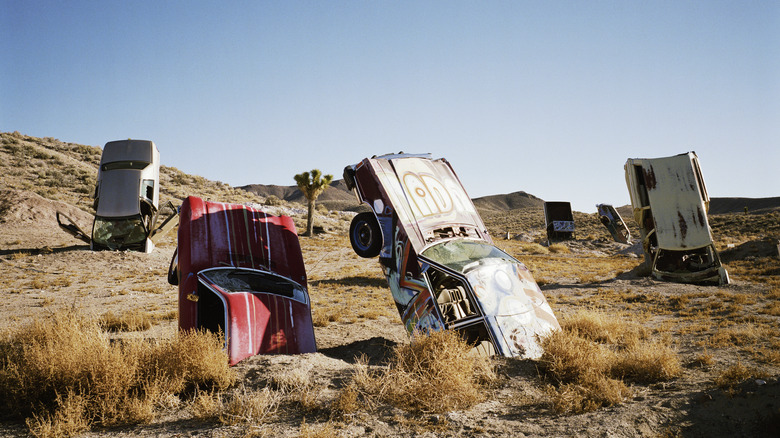The 'World's Greatest Gold Camp' Is A Near-Abandoned Nevada Ghost Town With Quirky Roadside Attractions
Goldfield, Nevada. Population: 200 people, two donkey-dummy boards, one sagebrush saloon filled with Old West curios, and the International Car Forest of the Last Church, where gaudily painted buses and cars stick straight out of the dirt like headstones. If that description doesn't sell the place, nothing will. Plus, there's a 1908 headstone in the town's historic cemetery that dryly reads, "Died Eating Library Paste." Could this place get any cooler?
In a nutshell, Goldfield is a semi-living ghost town nearly 3 hours northwest of Las Vegas along U.S. 95. The town has been reduced to its kitschiest and kookiest elements from its lofty moniker, "The World's Greatest Gold Camp." Though it looks like the Old West, it sprang up in 1902 as a gold-mining boomtown that swelled and died like a flash fire — producing $86 million (over $3 billion today) in gold, and already dwindling by 1910. A flood in 1913 and a fire in 1923 effectively ended the boom, though the town lingered on.
Today, Goldfield is a speck in the American Southwest amid sage-covered hills and flat desert plains. Walking through it just might be the closest any of us get to tromping spur-studded boots through the swinging doors of a saloon. Crumbling wooden shacks stand beside sun-stripped, battered roadside vehicles. An abandoned, two-pump gas station sits across from the Dinky Diner with its bent "Daily Special" sign. The saloon-shaped visitor center is down the street from the ruined red brick of the Goldfield Hotel, the Goldfied Courthouse, and the Old School House. And then there are the actual ghosts, which you just might encounter on a ghost tour through town.
Tour Goldfield's sign-coated attractions and curio-filled saloon
Without a doubt, the most fun you can have in Goldfield is simply strolling or driving around the town's wide, dusty streets. Residents still live here, unlike Nevadaville, Colorado, another once-thriving gold mining ghost town. Be mindful when snapping pictures of Goldfield's many weird and quirky structures and objets d'art.
Take the bar built on the site of the Old Mohawk Saloon that burned down in 1923. Sitting at the corner of Crook Avenue and Main Street, it's an invitation-only, private bar covered in road signs of all types. It sits across from what looks like a pile of rusted junk, old appliances, and odd memorabilia from the now permanently closed Mohawk Vintage shop. Down the street is the Goldfield Art Car Park Gallery , a truly bonkers, Mad Max-looking outdoor museum composed of broken vehicles haphazardly adorned with bizarre and tacky objects.
Farther down the same street are the aforementioned red-brick historical buildings and the DInky Diner, a saloon-looking eatery serving simple, inexpensive fare, surrounded by gravel and rusted farm equipment. On the way to grab a bite, you can make a quick side trip to the Goldfield historical landmark that reads: "The World's Greatest Gold Camp." Farther south is the Hidden Treaure Trading Company, where you can buy a Goldfield bauble to take home. The glorious Santa Fe Saloon and Motel caps the whole experience — a cozy bar that doubles up as a living Old West museum, complete with pool table, slot machines, and if you're lucky, locals with stories to tell.
Head through the International Car Forest on the way out of town
The International Car Forest of the Last Church is definitely Goldfield's most standout attraction. As the story goes, artist Chad Sorg was passing through the area when he saw a car sticking out of the dirt, nose down. That single car had been planted by artist Mark Rippie, whom Sorg later tracked down. In 2011, Sorg moved to Goldfield with the express purpose of expanding the car forest into an open-air desert art installation.
At present, the International Car Forest of the Last Church features 40 vehicles, including a school bus, airboat, vans, numerous cars, along with half-sunk tires and scattered barrels. Many are spray-painted in florid patterns and eye-jarring colors that look like the work of a frantic midnight madman. Best of all, it's free. There's no booth, gate, or anything else you have to pass through except the road itself. The whole experience is emblematic of America's obsession with cars, especially as tied to road trips, which in turn reflects the westward expansion and opportunism that created, and ultimately doomed, Goldfield.
The car forest makes a natural transition point for heading back on the road. If you've already ventured to Goldfield, Berlin-Ichthyosaur State Park is an equally strange stop – a ghost town that contains fossilized dinosaur remains. Goldfield is also not far from Avi Kwa Ame, the world's largest Joshua tree forest. The contrast is surreal: Revered Joshua trees rising from the ground after you've just seen their metal, manmade, decaying counterparts in Goldfield.


